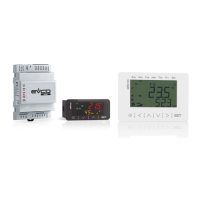EVCO S.p.A.
EV3 MVC & EVD MVC | Application manual ver. 2.2c | Code 1443DMVCI224
page 51 of 74
In order to use this function, the
recovery heat exchanger/bypass damper
or
Compressor
(if the recovery heat exchanger is
thermodynamic) relay must be configured. Cross-flow recovery heat exchanger is a passive system, meaning that when activated the
corresponding relay is in rest position. When the recovery heat exchanger is inactive the corresponding relay opens the bypass damper.
Rotary and thermodynamic recovery heat exchangers are active systems meaning that the corresponding relay must be active for the
exchanger to operate.
Irrespective of the type, the recovery heat exchanger is always operating other than in the following situations when it is deactivated:
- If the fans are in alarm mode or the machine in standby mode (only in the case of active recovery heat exchanger since the energy
exchange would be nil while there would be energy consumption required to keep the exchanger active)
- If the mixing chamber damper is completely closed for the same reason as above (in this case the return fan is switched off)
- If the free heating or free cooling functions are activated.
If the expulsion temperature falls below the critical value d11, the rotary recovery heat exchanger stops or the bypass damper for the
cross-flow recovery heat exchanger opens. Normal operation is restored when the expulsion temperature rises above the threshold
(d11 + d10/2).
10.4.1 Defrosting cross-flow or rotary recovery heat exchanger
During the winter cycle, the recovery heat exchanger exchanges heat between the flow of expelled air (hot and humid) and the input
air (cold and dry). If the external air is particularly cold, the expelled air flow temperature can fall to freezing point, risking obstruction
of the exchanger and impeding normal air flow.
To prevent this happening, the expelled air flow temperature should be prevented from falling excessively by constantly monitoring it
and, when needed, first slowing down just the supply fan and then both fans.
Adjustment takes place on the temperature of the expulsion probe in the neutral zone with setpoint d09, band d10, step C12 and time
C13: if the temperature is too low (<d09 - d10/2)
the speed of the supply fan is reduced relative to that of the return fan up to a
maximum differential (d12) always taking into account any balancing of the C35 speeds which is always valid; if the need for defrosting
persists, the speed of both fans will be reduced in parallel down to the minimum permitted speed (C06).
If
, however, the expulsion
temperature falls below the critical value d11, the rotary recovery heat exchanger stops or the bypass damper for the cross-flow
recovery heat exchanger opens.
The fan speeds gradually return to their normal value when the expelled air temperature rises above the value of d09+d10/2.
Regardless of the fan speed regulation settings these are suspended while defrosting is in progress. When defrosting is finished, the fan
speed regulation returns to the normal settings.
In the event of manual regulation, it is possible to set a different value for the fan speeds, but this value will only be valid when
defrosting is finished.
10.5 Regulating the mixing chamber damper
When present, the mixing chamber damper regulates the quantity of recirculated air and external air emitted into the room (damper
completely closed = all recirculated; damper completely open = all external air).
The percentage of damper opening therefore influences the following factors:
- Temperature (free cooling/heating and off band)
- Humidity (winter dehumidifier)
- CO
2
.
The controller regulates the opening of the mixing chamber damper using the modulating 0-10 V output; to activate the function the
Mixing chamber damper analogue output should be configured.
This regulation works with that of the fans both in terms of the percentage increase/decrease (C12) and the relative timing (C13).
In normal conditions the damper is open by at least the minimum opening percentage (C08) to guarantee the minimum air exchange in
the room.
There are some conditions in which the minimum opening setting is not applied (damper completely closed):
- If the machine is in stand-by
- If the regulation temperature is "off-band"
- If the fans are in alarm mode.
If the free cooling or free heating functions are activated, the mixing chamber damper is completely open.
In all other situations the damper opening depends on the configuration of the machine in the following order of priority:
- If the CO
2
sensor is configured and not in alarm mode, the damper opening depends on the value detected by this probe as described
in the relevant paragraph.
- If the humidity sensor is configured and not in alarm mode, the "heating" function activated and the winter dehumidifier enabled, the
damper opening depends on the value detected by this probe as described in the relevant paragraph.

